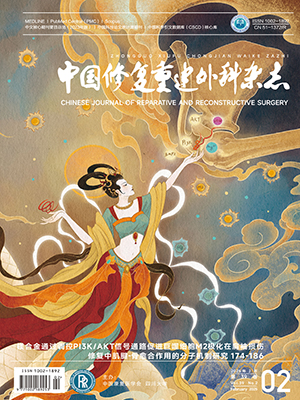| 1. |
Kandwal P, Vijayaraghavan GP, Nagaraja UB, et al. Severe rigid scoliosis: review of management strategies and role of spinal osteotomies. Asian Spine J, 2017, 11(3): 494-503.
|
| 2. |
Zhang Y, Hai Y, Tao L, et al. Posterior multiple-level asymmetrical ponte osteotomies for rigid adult idiopathic scoliosis. World Neurosurg, 2019, 127: e467-e473.
|
| 3. |
Mallepally AR, Mahajan R, Rustagi T, et al. Is VCR necessary to correct very severe deformity? Case report and review of literature. Int J Neurosci, 2020. [Epub ahead of print].
|
| 4. |
Lee BH, Hyun SJ, Han S, et al. Surgical and radiological outcomes after posterior vertebral column resection according to the surgeon’s experience. Medicine (Baltimore), 2018, 97(34): e11660.
|
| 5. |
王号中, 修鹏, 汪雷, 等. 儿童及青少年脊柱畸形矫形围术期疼痛管理的研究进展. 中国修复重建外科杂志, 2019, 33(5): 644-649.
|
| 6. |
Mohamed Ali Hussien, Mohamed Abdulsalam Wafa, Ahmed mohamed Elbadrawi, et al. Posterior vertebral column resection for congenital rigid spinal deformities. Current Orthopaedic Practice, 2019, 30(4): 361-369.
|
| 7. |
Iyer S, Duah HO, Wulff I, et al. The use of halo gravity traction in the treatment of severe early onset spinal deformity. Spine (Phila Pa 1976), 2019, 44(14): E841-E845.
|
| 8. |
Shimizu T, Lenke LG, Cerpa M, et al. Preoperative halo-gravity traction for treatment of severe adult kyphosis and scoliosis. Spine Deform, 2020, 8(1): 85-95.
|
| 9. |
McIntosh AL, Brandon SR, Charles JC, et al. Halo gravity traction for severe pediatric spinal deformity: A clinical concepts review. Spine Deformity, 2019, 7(3): 395-403.
|
| 10. |
Davies NR, Vasquez Rodriguez V, Remondino RG, et al. Inpatient versus outpatient halo-gravity traction in children with severe spinal deformity. Spine Deform, 2020. [Epub ahead of print].
|
| 11. |
王华锋, 刘辉, 郑召民, 等. 后路脊柱截骨术与牵引辅助后路广泛松解术治疗重度脊柱畸形的比较研究. 中国骨与关节杂志, 2014, 3(12): 896-900.
|
| 12. |
Koller H, Zenner J, Gajic V, et al. The impact of halo-gravity traction on curve rigidity and pulmonary function in the treatment of severe and rigid scoliosis and kyphoscoliosis: a clinical study and narrative review of the literature. Eur Spine J, 2012, 21(3): 514-529.
|
| 13. |
Lenke LG, Sides BA, Koester LA, et al. Vertebral column resection for the treatment of severe spinal deformity. Clin Orthop Relat Res, 2010, 468(3): 687-699.
|
| 14. |
Qiao J, Xiao L, Xu L, et al. Skull-femoral traction after posterior release for correction of adult severe scoliosis: efficacy and complications. BMC Musculoskelet Disord, 2018, 19(1): 277.
|
| 15. |
Xie JM, Zhang Y, Wang YS, et al. The risk factors of neurologic deficits of one-stage posterior vertebral column resection for patients with severe and rigid spinal deformities. Eur Spine J, 2014, 23(1): 149-156.
|
| 16. |
Takata Y, Lenke LG, Kelly MP. Posterior vertebral column resection for rigid proximal thoracic kyphoscoliosis with broken growing rods in a patient with Desbuquois dysplasia. Spine Deform, 2020, 8(1): 135-138.
|
| 17. |
Riley MS, Lenke LG, Chapman TM Jr, et al. Clinical and radiographic outcomes after posterior vertebral column resection for severe spinal deformity with five-year follow-up. J Bone Joint Surg (Am), 2018, 100(5): 396-405.
|
| 18. |
Yang C, Wang H, Zheng Z, et al. Halo-gravity traction in the treatment of severe spinal deformity: a systematic review and meta-analysis. Eur Spine J, 2017, 26(7): 1810-1816.
|
| 19. |
Bao H, Yan P, Bao M, et al. Halo-gravity traction combined with assisted ventilation: an effective pre-operative management for severe adult scoliosis complicated with respiratory dysfunction. Eur Spine J, 2016, 25(8): 2416-2422.
|
| 20. |
Smith JS, Sansur CA, Donaldson WF 3rd, et al. Short-term morbidity and mortality associated with correction of thoracolumbar fixed sagittal plane deformity: a report from the Scoliosis Research Society Morbidity and Mortality Committee. Spine (Phila Pa 1976), 2011, 36(12): 958-964.
|
| 21. |
Chang DG, Yang JH, Lee JH, et al. Congenital scoliosis treated with posterior vertebral column resection in patients younger than 18 years: longer than 10-year follow-up. J Neurosurg Spine, 2016, 25(2): 225-233.
|
| 22. |
Wang Y, Zhang Y, Zhang X, et al. A single posterior approach for multilevel modified vertebral column resection in adults with severe rigid congenital kyphoscoliosis: a retrospective study of 13 cases. Eur Spine J, 2008, 17(3): 361-372.
|




